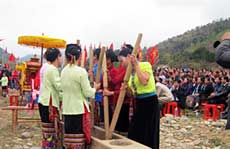Thai people in North Western Vietnam have a unique and delicious dish of fresh water fish indispensable at their traditional weddings.

Having lived for centuries at the foot of the mountains and by the rivers or streams they have many of their customs and traditions connected with the rivers, streams and rice cultivation, like praying for rain, worshipping the thuong luong (a dragon-like river monster) and splashing water over people on New Year’s Day, not to mention legends about young lovers.
Fish, easy to catch from the rivers and streams, have become a special dish of the Thai ethnic community, especially on special occasions such as weddings or funerals. It is called pa bẳng (salted fish) and pa hắp (baked-dry fish), or “bẳng hắp†in short often brought by the groom’s family to the bride’s house at a traditional Thai wedding.
The Pa bẳng is made from delicious fresh water fish such as cá xinh, cá khuy or cá chép (carp). The fish is first cleaned and mixed with salt, crushed galingale and powdered grilled rice, then placed inside a large bamboo tube, wrapped tightly in dong (phrynium) leaves and left to ferment. When it is ready to be taken to the bride’s house, it is placed inside a thinly-woven net of bamboo strings. The mouth of the bamboo tube is bound with a mesh of beautifully-coloured bamboostrings, which are also used to create handle straps. The pa hắp is made from the same fish; it is cleaned, mixed with salt and placed into a basket lined with dong leaves, then placed on a bamboo frame above the kitchen stove to bake-dry. On ceremonial occasions, the pa hắp is placed in small baskets with handles woven from colourful woven cloth. Both bẳng and hắp must be grilled before eating.
So why are these dishes so indispensable to a Thai wedding? To many Thai people, it is simply a question of taste. After all the time and effort involved in bringing up a daughter until she is old enough to take a husband, only the most delicious fish will suffice to celebrate her marriage and treat the whole village. Senior members of the family and relatives coming from a far to attend the party often receive gifts of bẳng hắp from the host to take back home with them so that they can share these succulent foods with those who were unable to attend the wedding. And in the process, those who receive these dishes feel greatly appreciated and respected by their host.
But there are also symbolic reasons why these two dishes play such an important role in the Thai wedding ceremonial. It is said that the pa bẳng fermenting in the bamboo tube and the pa hắp bake-drying on the kitchen frame above the stove represent yin and yang, helping the new couple to have compatible and happy life, like the relationship of fish to water. And being aquatic animals, fish propagate easily. So the presence of fish among the ceremonial offerings also represents the desire to have children and a smooth and prosperous life after marriage.
Traditionally, the bride’s family dictates the number of bẳng hắp dishes brought by the groom’s family to the bride’s house, but if the groom’s family is poor, they can negotiate with the bride’s family to bring a lesser quantity. However, the two dishes must always be brought together in pairs and the total number of pairs must always be an even one.
Sadly, the bẳng hắp no longer features as prominently as it once did in Thai ethnic wedding ceremonies. This is partly a consequence of cultural interaction between people of different ethnic groups, but also reflects the fact that in many regions in the north river fish is not as plentiful as it used to be. But these unique dishes remain symbols of the Thai cultural heritage and are thus of considerable interest to both ethnologists and gourmets alike.